Croatia, Slovenia and Montenegro Trip
9/19/2019-10/7/2019
Join Friendly Adventures on our Croatia, Slovenia, and Montenegro tour. It will be a colorful, interesting and multifaceted tour. While you soak up the beautiful scenery of these Adriatic jewels, you’ll appreciate the fascinating story that puts these countries into historical and cultural perspective. Our trip winds past turquoise lakes, medieval castles, emerald mountains, Roman ruins and lingers on the beautiful Adriatic Sea. Highlights include The mysterious island of Hvar, the stunning Plitvice Lakes National Park, the wonders of Slovenia's Lake Bled and Croatia's most famous city - Dubrovnik. This escorted trip includes many of the region’s many treasures and allows ample free time to discover others. Ready to be amazed? Ready to experience the Mediterranean as it once was? Then this adventure is a perfect choice for you!
We will start our trip with tours of the historic capital cities of Zagreb, Croatia and Ljubljana, Slovenia. Then we will spend two nights lakeside in Bled while enjoying hikes and scenery in Triglav NP, and touring Postojna Cave. Next, we will hike in Plitvice Lakes, enjoy a full day island excursion to Kornati NP and spend several days exploring historic medieval towns of Zadar, Split, and Trogir. In-between we hike through the magical Krka NP and Mt Biokova nature park and sleep in the Makarska Riviera. We will spend the next several days in the Adriatic Sea exploring through the Croatian islands of Brac, Hvar, and Korcula before heading back to the mainland to go wine tasting in the Peljesac peninsula. Finally, we finish our trip with several days in beautiful Dubrovnik with a side trip to Montenegro. Many of the above sights and towns we experience on this trip are cultural, historical or natural UNESCO World Heritage Sites and just fantastic.
Each participant will be responsible for making their airline arrangements. Please note that this trip begins in Zagreb, Croatia and ends in Dubrovnik, Croatia. See flight info tab below for information!
HighlightsGeneral ItineraryFlight InfoCancellation Policy
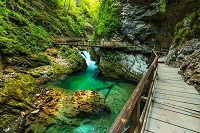
Triglav National Park
The Triglav National Park is the only national park in Slovenia and lies in the immediate vicinity of Bled. It comprises one of the most beautiful and attractive areas of Slovenia, almost the entire Slovenian part of the Julian Alps. The territory of the National Park is very picturesque and varied. The highest mountain in Slovenia, Triglav (2864 m), after which the park was named, lies in its centre. From Triglav, deep and sharply cut valleys, mainly of glacial origin, open on all sides in the form of a fan. The valleys and plateaux are covered by a carpet of green forests and meadows. Bold, high pointed mountain peaks rise above them, with dark and deep abysses. Clear mountain streams and small rivers run in the numerous gorges and beautiful ravines and troughs (Vintgar, Mlinarica, Mostnica) and flow into two larger rivers – the Sava and the Soča. The watershed between the Adriatic and the Black Sea runs between them. There are mountain lakes (the Triglav Lakes, Kriška Lakes, etc.) high in the mountains, and Lake Bohinj, the largest permanent natural lake in Slovenia. This magnificent and rugged landscape is inhabited by an extremely rich variety of flora and fauna with numerous rare and protected plant and animal species. At the edge of the park, where man has been master for many centuries, history and human culture have left their traces.
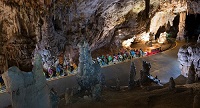
Postojna Cave
Postojna Cave is the largest Karst cave in Slovenia with as much as 24 km of underground tunnels. Take an unforgettable ride on Postojna Cave’s underground train and experience a fascinating subterranean paradise shaped by tiny droplets over millions of years. Postojna Cave is the only place where you can see the most precious brilliant in the form of a cave formation and also meet the baby dragons. Just like the world above the surface, Postojna Cave boasts towering mountains, murmuring rivers and vast subterranean halls. It is a real challenge for explorers and the cradle of speleobiology.
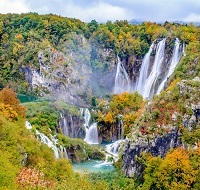
Plitvice Lakes National Park
Nested in mountainous Lika region, half-way between the coast and the capital Zagreb, Plitvice Lakes National Park is, along with Dubrovnik, the single most visited site in Croatia. Plitvice Lakes became protected national park back in 1949, and since 1979 the place is also listed as UNESCO World Heritage Site. The beauty of the National Park lies in its sixteen lakes, inter-connected by a series of waterfalls, and set in deep woodland populated by deer, bears, wolves, boars and rare bird species. The National Park covers a total area of 300 square kilometres, whilst the lakes join together over a distance of eight kilometres. The mineral composition of Plitvice creates an array of stunning colours in the lakes, from teal to azure, green, grey and blue. The crystal clear water provides a brilliant view of some extremely fat fish. The water itself is high mountain runoff and, because the water calcifies everything it touches, there’s no mud or algae, which keeps the water clear. While it looks enticing, swimming is prohibited.
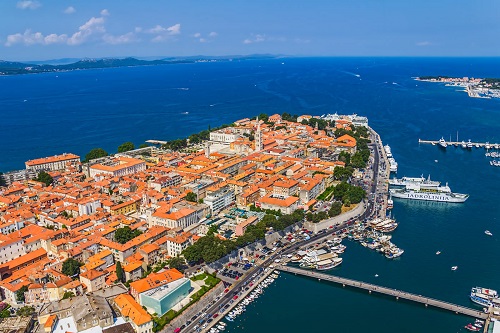
Zadar
Trust Dalmatians to coin words that have no equivalent in English. Only on the Croatian coast do you require concepts like pomalo - 'to live free from time', or fjaka, a lazy mood of complete contentment. Take off your watch, kick back, pomalo. Holiday nirvana. Not long ago pomalo was the very essence of a Dalmatian city break. Now Dubrovnik seethes in summer and Split is a holiday mill. So welcome to Zadar - coastal Croatia's new capital of cool. A former fortress of the Venetian Republic, Zadar old town is a place to winkle out interesting secrets at holiday pace. It is small enough to circle in a morning yet large enough to offer exploration for days. Picture a walled town poked into a deep clean sea. Pave it with marble polished by centuries of wear and furnish it with Italianate buildings the colour of old ivory. Add a romantic Balkan heart. Now drench it in brilliant Adriatic light.
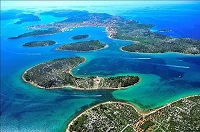
Kornati National Park
The Kornati archipelago has qualities that make it unique. It is made up of 140 islands and islets in an area only 35 kilometres long and 14 kilometres wide. Between the long, thin island of Kornat, which faces the coast, and the chain of islands on the other side, there is a stretch of water naturally protected from the open sea, with dozens of safe bays to drop anchor. Once you pass through one of the two narrow gates to the north and south, you leave the worst of the waves behind, and enter a strange, other-worldly environment, of treeless hills. The islands on the inside of the national park seem deserted. You might sight the occasional sheep, or a small votive chapel, built by a grateful sailor saved from a storm by the natural barrier of the islands, otherwise there’s little sign of human habitation. It’s a very meditative and minimal landscape, unlike any other island chain in the Adriatic. When you enter Kornati, you’ve arrived somewhere completely different.
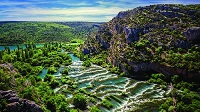
Krka National Park
Krka National Park lies about 10km inland from Sibenik in this part of Dalmatia. Named after the Krka River, the Park covers an area of just over 142 square km and includes two thirds of the river itself. The top attraction of the Park are its magnificent waterfalls, including the famous Skradinski Buk falls which are one of Croatia’s most famous sights. Other highlights include the small island of Visovac and Roski Slap waterfall. A boat trip through the park is a great way of seeing much of the Park. Best of all, it is possible to swim in some locations in Krka National Park! (To be sure to bring your swimming costume or trunks along!)
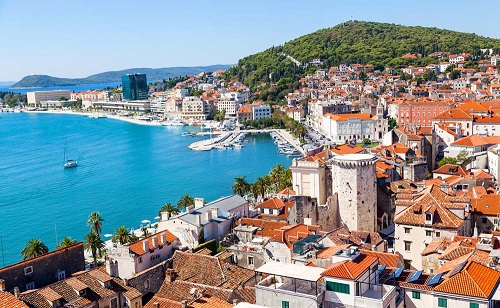
Split
Croatia’s second largest city is an alluring place. Facing the twinkling Adriatic, and with a dramatic mountain backdrop, its setting is stunning. City life still focuses on the remarkable and extensive Roman remains of Diocletian’s Palace. A UNESCO World Heritage Site, the walled complex was built as an imperial palace and military fortress for the emperor at the turn of the fourth century AD. Spend a day following ancient footsteps – starting from the Peristil (the colonnaded open courtyard) and cathedral, and wander through the ancient maze of narrow streets and little squares. (Near the Peristil is the oval, open-roofed Vestibul, where traditional klapa singing groups making use of the fine acoustics.) Shops, restaurants, churches, houses: everyday life is built into the very fabric of the ancient walls. Perhaps unsurprisingly, they caught the eye of the makers of Game of Thrones, and walking tours of the locations featured in the hit series are easily found.
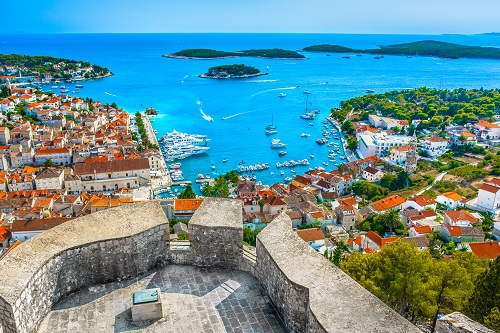
Hvar
The Dalmatian coast is fast becoming the French Rivera of the east, and Hvar is unquestionably its St Tropez. Although it has been a popular with yacht-goers of the Mediterranean for years, its relative inaccessibility has meant that it managed to hold on to its special tranquil beauty. And it's easy to see the appeal: the Adriatic air smells of lavender as the rocky hills surrounding Hvar town itself are blanketed in purple. At the bottom of the slopes, the harbour town curves around the south-facing bay, with those yachts bobbing on the crystal clear water.
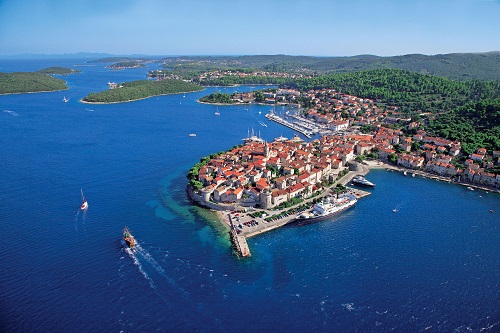
Korcula
Korcula is considered as the pearl of the southern Dalmatia and offers to its visitors picturesque walled old town of Korcula, magnificent coastal panoramas, dreamlike fishing villages and idyllic coves. Away from the tourist-places on the coast of the island Korcula, in the island's interior one discovers a unique green landscape with panoramic views and hidden cultural treasure, which one can discover either on foot or by bicycle. The coast of the island of Korcula is very indented with a large number of bays and coves. Korcula enchants the senses with its timeless beauty and casts an everlasting spell of wonder on those who tread upon its ancient stone.
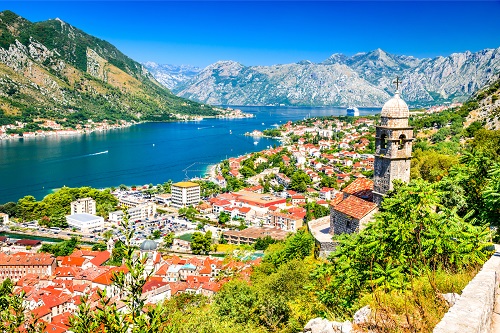
Montenegro
Montenegro is a tiny – often overlooked – Balkan country flanked by Bosnia & Herzegovina, Serbia and Albania. It’s blessed with a beautiful strip of coastline, rugged peaks and medieval villages. On Montenegro trips you can wake up to views of the Adriatic Coast, eat lunch on the banks of Lake Skadar and enjoy an evening hike in the mountains. The country’s recent, turbulent history is never far from the surface but Montenegro rewards the curious traveller with natural wonders. The tranquil Luštica Peninsula is a rural headland of hidden beaches and remote villages wrapped by olive groves. And the Old Town of Kotor, at the heart of the country’s wine-growing region, will enchant you; its sheltered bay attracts the yachting set, but fjord-like in its beauty and dotted with coastal churches, it’s a refreshingly unglitzy place.
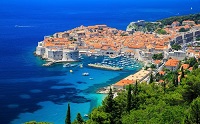
Dubrovnik
If you’ve never been to Croatia, the one thing you should know is that it’s downright dazzling, and the city of Dubrovnik is the epitome of such beauty. Crystal clear waters glisten under the sun; boats, one of the primary forms of transportation in the area, dot the sea in every direction; and the medieval limestone walls of the Stari Grad that safeguard the terra cotta–roofed buildings are impressive. The city is a living museum and a live stage, and has an ideal connection between its historical past and the modern day. It is surrounded by medieval walls that are 1940 metres long and are preserved in their original form. They are open to visitors and are the city’s greatest attraction. Since 1979 the town has been under UNSECO protection. Dubrovnik is a city that charms, a city that you fall in love with and always return to like new, to discover more unique experiences.
Subject to change. Please listen for announcements during the trip that may affect the schedule.
Breakfast and Dinner included.
Day 0 - 09/19, Thursday – 09/20, Friday
Depart for Zagreb, Croatia depending on your flight and if you want to arrive early to explore in Zagreb on your own. Flights can range from 13 to 34 hrs.
Day 1 – 09/21, Saturday (D)
Accommodations: Zagreb - Hotel Aristos
No. of nights: 1
Arrive in Zagreb, Croatia! Transfer to hotel. Zagreb, the capital of Croatia, is a lively and colorful city, reasonably manageable on foot. If you arrive early, you can spend time enjoying the beautiful architecture, the old town and monuments. Zagreb is located in the northwest, along the Sava river, at the southern slopes of the Medvednica mountain. It lies at an elevation of approximately 122m (400ft) above sea level. The estimated population of the city in 2018 was 810,003 - approximately a quarter of the total population of Croatia!
Day 2 – 09/22, Sunday (B,D)
Accommodations: Bled - Hotel Rikli Balance
No. of nights: 2
Guided tour of Zagreb. In the morning enjoy a guided walking tour of Zagreb - from the city’s historic past to its vibrant present. Our exact route will be determined by our local guide, but may include landmarks such as Zagreb's cathedral, Kamenitavrata (Stone gate), the colorful farmers’ market, the renowned church of St. Marko, the Croatian parliament, the Lower Town with its famous monument of Ban Jelacic, and Manduševac fountain. Also, the group takes a ride on the funicular railway, the shortest cable car in the world.
Next we proceed to Ljubljana, the capital of Slovenia, a city full of style and sophistication, and a treasure-trove of history, monuments,churches, museums, and great restaurants. On arrival you’ll take a guided tour around the old city center, renowned for its unique architectural appearance. The Old Town consists of three main squares and baroque houses. We’ll visit Ljubljana Castle, the Town Hall, Cathedral of St. Nicholas and the Dragon Bridge. The group takes a cable car to Ljubljana castle to enjoy the best viewpoint in the city.
After touring the capitals we head to Lake Bled, our home for 2 nights and an amazing jewel of nature nestled at the foot of the Julian Alps. Slovenia’s only island, Bled Islet is located in the middle of an alpine lake with mountains as a backdrop. This spectacular location inspired Slavic populations to venerate Ziva, the goddess of love and fertility. Later, Christians built a church here that is still visited by pilgrims today.
Day 3 – 09/23, Monday (B,D)
Depart for a 1/2 day excursion to Triglav National Park. This morning we will walk along Vintgar Gorge,carved by the pristine Radovna River, within Triglav NP. Triglav is Slovenia’s only national park and one of the earliest national parks in Europe. We will then walk through the small towns along the road back to Bled. After lunch we will have free time in Bled to walk or bicycle around the lake and enjoy the scenic views or cross the lake by traditional pletna boat to Bled Islet and visit Bled's castle.
Day 4 – 09/24, Tuesday (B,D)
Accommodations: Plitvice lakes - Hotel Macola
No. of nights: 2
Depart early for Predjama castle and then to Postojna Cave. Predjama castle is a 12th century Renaissance castle built within a cave mouth, Postojna is the largest classic karst cave in Europe. In 1872, railway lines were laid in the cave and electricity arrived in 1884. Begin with a 2-kilometre open-top train ride through narrow tunnels to this jungle of stalactites and stalagmites. After the visit we will have a late lunch (2pm) and then transfer to Korenica, Plitvice lakes.
Day 5 – 09/25, Wednesday (B,D)
Depart to visit Plitvice lakes with licensed tour guide. By far Croatia's top natural attraction and one of the oldest national parks in Southeast Europe and the largest in Croatia, this glorious expanse of forested hills and turquoise lakes is exquisitely scenic, so much so that UNESCO proclaimed it a World Heritage Site. Enjoy a walking tour which is famous for its 17 lakes connected by a series of waterfalls. We will see all of the highlights of the park (both Lower and Upper lakes). Cap off your visit with a boat cruise across the Kozjak Lake and a panoramic train ride, soaking up the breathtaking views.
Day 6 – 09/26, Thursday (B,D)
Accommodations: Zadar - Hotel Kolovare
No. of nights: 2
Guided tour of Zadar - Croatia’s coolest city. Boasting an historic old town of Roman ruins,medieval churches, cosmopolitan cafes and quality museums set on a small peninsula, Zadar is an intriguing city. It’s not too crowded and its two unique attractions – the sound-and-light spectacle of the Sea Organ and the Sun Salutation – need to be seen and heard to be believed. After the tour the guests can enjoy the beauties of Zadar in their free time.
Day 7 – 09/27, Friday (B,D)
Depart to Sukosan, a harbor where we take a full day ship excursion to Kornati National Park. During the day, lunch, snacks and drinks are included. In your free time consider a hike/walk/snorkel/swim in Kornati NP.
Day 8 – 09/28, Saturday (B,D)
Accommodations: Makarska Riviera, Hotel Alga or Afrodita
No. of nights: 3
Depart to Krka National Park. Visit of the park with a licensed guide. It’s a magical place of waterfalls and gorges, with the river gushing through a karstic canyon 200m deep. It's the most dramatic natural sight in the region. The highlight of Krka NP - an hour-long loop - follows boardwalks,connects little islands in the emerald-green, fish-filled river and terminates at the park's largest waterfall. Skradinski Buk's 800m-long cascade descends by almost 46m before crashing into the lower lake, which is a popular swimming spot. Nearby,a cluster of historic mill cottages have been converted into craft workshops,souvenir stores and eateries. You will see the beautiful lakes and waterfalls from location Lozovac. After the visit we depart to Tucepi, on the Makarska Riviera.
Day 9 – 09/29, Sunday (B,D)
Depart on a full day excursion to explore in Split and Trogir. In Split, we visit the most important sites of the city including the famed Palace of Diocletian (one of the best preserved monuments of roman architecture in the world) and Peristil (the beautiful square in the Palace). The tour ends in Prokurative, a common place for people watching with sea views. We continue along the coastal road for 30mins (on bus) and we visit gorgeous Trogir set within medieval walls on a tiny island, linked by bridges to both the mainland and to the far larger Ciovo Island. Enjoy this beautiful small island with roman ruins, rich history and a wide seaside promenade.
Day 10 – 09/30, Monday (B,D)
Depart to Biokovo Nature Park. Get ready for a combination of hairpin bus ride and hiking tour through rock formations, olive trees, ruins from old settlements, unique plant life and numerous animal species. We’ll stop to admire the stunning views of the sea and the islands along the coastline of Markaska Riviera and allow time to rest and enjoy the beauty of the Dalmatia coast.
Day 11 – 10/01, Tuesday (B,D)
Accommodations: Hvar - Senses Resort
No. of nights: 2
Wake up early for an 8am departure on the ferry from Makarska to Sumartin on Brac Island (1hr sail). We’ll board the bus and take a tour of Brac Island with a licensed guide. Tour might include its history, old settlements, stone cutting tradition, a visit to the forests or mountain peaks for panoramic views and/or a swim in a famous beach. Next we jump on board a catamaran and take a 1hr ride to Hvar island. The bus will be waiting with the luggage to bring the group to our next accommodation in Vrboska on Hvar island.
Day 12 – 10/02, Wednesday (B,D)
Hvar island is known as the island of natural beauty and considered the sunniest island in Croatia! Today we’ll be sightseeing on the eastside in Vrboska, Jelsa and Gdinj plus take in scenic views of wine fields.
Day 13 – 10/03, Thursday (B,D)
Accommodations: Korcula - Hotel Port 9
No. of nights: 1
We’ll take a tour on the westside of Hvar island in Stari Grad and Hvar town. After the excursion, we’ll board the ferry to Korcula for an 1 ½ hr sail where the bus will be waiting with the luggage to bring the group to our next accommodation on Korcula island.
Day 14 – 10/04, Friday (B,D)
Accommodations: Dubrovnik - Hotel Valamar Club or Tirena Sunny Hotel
No. of nights: 3
Put on some comfy shoes and get ready to sight see on foot in the beautiful ancient city of Korcula, birthplace to Marco Polo and jewel of the Adriatic Sea. After sightseeing, we’ll board a ferry to Orebic (mainland) and continue through the picturesque landscape of Peljesac peninsula, known for its wine district. We’ll use this opportunity to make a stop at one of the most popular wine cellars in southeast Europe named Matusko for a tour of their impressive cellar and wine and cheese tasting. Cheers!
Day 15 – 10/05, Saturday (B,D)
Depart at 9am for the Republic of Montenegro. First we head to the mouth of the Bay of Kotor, the longest and deepest fjord in southern Europe, to board a ferry for a walking tour in the city of Kotor steeped in tradition and history with remarkable scenic views. This city was built between the 12th and 14th centuries and is filled with medieval architecture and historic monuments. Next we visit Budvar, part of the Budva riviera, known for sandy beaches and nightlife. Stone walls built by the Venetians surround the narrow streets of the medieval old town. On the way back to Dubrovnik, Croatia, we’ll be taking the scenic road with a short stop in the charming coastal town of Perast.
Day 16 – 10/06, Sunday (B,D)
Guided tour of Dubrovnik, Croatia. The bus will drop us off in the city center where we’ll start the tour of the old city,a UNESCO World Heritage Cultural Site. We’ll visit the Franciscan Monastery, the Rector Palace and the Cathedral. Enjoy some free time in city center to shop or relax.
Day 17 – 10/07, Monday (B)
Our trip ends. Depending on departure flight time, transfer to the airport. Farewell and Safe Travels!
Each participant will be responsible for making their own airline arrangements. Please note that this trip begins in Zagreb, Croatia, and ends in Dubrovnik, Croatia.
Departures from LAX in pm on Sept 20, 2019 will arrive in Zagreb in am on Sept 21, 2019 or for better pricing you may consider Sept 19, 2019 departure with a layover in European city
Returns from Dubrovnik on Oct 7, 2019 will arrive in Los Angeles on same day/or next day with lay-over in European city
Currently, you can get a good flight schedule and rate by flying into Europe (paris) and then booking separate flight into Zagreb/out of Dubrovnik with one-way flights
The deposit for this international trip is $500 which goes toward the land package fee. Full payment is due by July 19, 2019.
Cancellation charges reflect the many expenses Friendly Adventures cannot recover if you cancel, even if you must do so due to illness, injury, or personal emergencies. These fees are not meant to be punitive in any way. The charges made reflect the expenses Friendly Adventures has incurred in administering your reservation and planning for your participation. We recognize that the majority of those who cancel their reservations do so out of necessity. Please note that we do not make any refunds for any unused portion of your trip, not arriving, arriving late, or leaving the trip early.
In the unfortunate event that you must cancel your trip, your land package refund will be determined according to the formula below.
Days prior to departure:
90+ days: Full refund
90 - 61 days: 50% of your land package fee payment
60 days or less: No refund
Friendly Adventures reserves the right to cancel or alter a trip due to unforeseen weather, unsafe conditions, low registrations or other circumstances. On the rare occasion when Friendly Adventures must cancel a trip, all payments received to date will be refunded, including the non-refundable portion of your deposit. Friendly Adventures is not responsible for expenses incurred in preparation for any canceled trips, including airplane tickets.
WE STRONGLY RECOMMEND TRIP CANCELLATION/TRIP INTERRUPTION INSURANCE, WHICH COVERS YOUR COST IF YOU NEED TO CANCEL OR INTERRUPT YOUR TRIP for medical reasons, trip delay, lost baggage, and other unforeseen emergencies. Friendly Adventures will send you information about travel insurance with your registration information, or you may purchase coverage through your own insurance company. In order to avoid disappointment and expense in the event that you must cancel your trip we strongly urge you to purchase some type of insurance coverage.
|
|
Make Reservation
Land package: $2,800
Departing from LAX Airport
Trip Includes
Ground transportation; hotel accommodations with breakfast & Dinner; licensed guides; Cable car in Zagreb; Postojna cave admission tickets, train in the cave; entry ticket to Plitvice lakes; Boat excursion NP Kornati, entrance fees NP Kornati, lunch and drinks on the ship; NP Krka entry tickets; Ferry tickets Makarska – Sumartin; Catamaran Ticket Bol – Jelsa; Catamaran ticket Hvar – Korcula; Sightseeing, wine and cheese tasting in famous cellar Matusko; City tax Kotor
Have a Question?
Send an e-mail to the organizers.
John Corcoran
Main Coordinator
Ron Domash
Assistant Coordinator
|